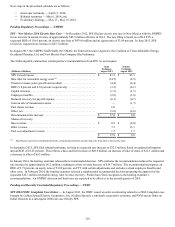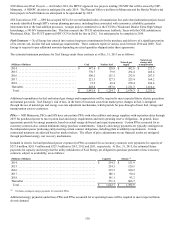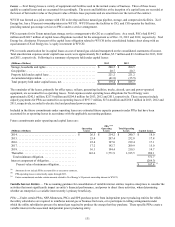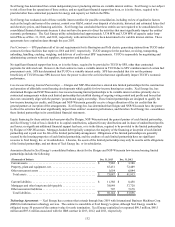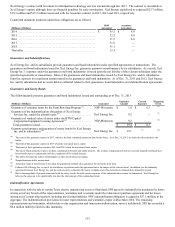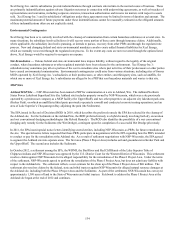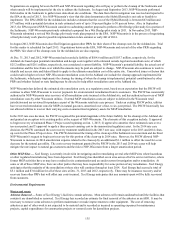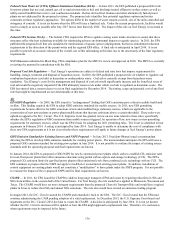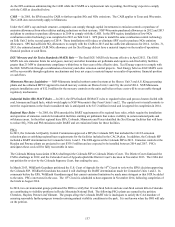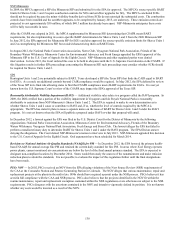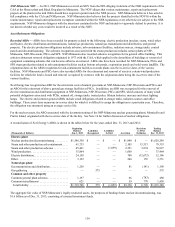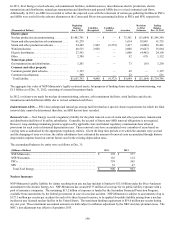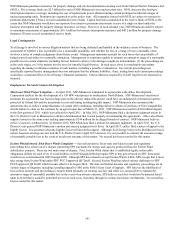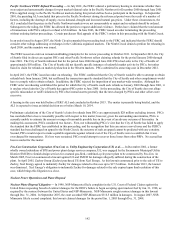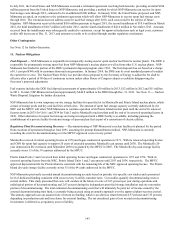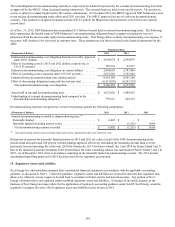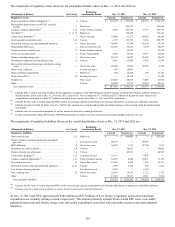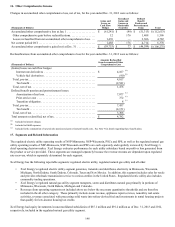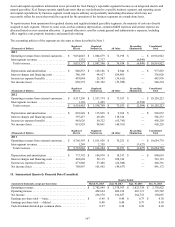Xcel Energy 2013 Annual Report Download - page 155
Download and view the complete annual report
Please find page 155 of the 2013 Xcel Energy annual report below. You can navigate through the pages in the report by either clicking on the pages listed below, or by using the keyword search tool below to find specific information within the annual report.
137
As the EPA continues administering the CAIR while the CSAPR or a replacement rule is pending, Xcel Energy expects to comply
with the CAIR as described below.
CAIR — In 2005, the EPA issued the CAIR to further regulate SO2 and NOx emissions. The CAIR applies to Texas and Wisconsin.
The CAIR does not currently apply to Minnesota.
Under the CAIR’s cap and trade structure, companies can comply through capital investments in emission controls or purchase of
emission allowances from other utilities making reductions on their systems. NSP-Wisconsin purchased allowances in 2012 and 2013
and plans to continue to purchase allowances in 2014 to comply with the CAIR. In the SPS region, installation of low-NOx
combustion control technology was completed in 2012 on Tolk Unit 1. SPS plans to install the same combustion control technology
on Tolk Unit 2 in the second quarter of 2014. These installations will reduce or eliminate SPS’ need to purchase NOx emission
allowances. SPS had sufficient SO2 allowances to comply with the CAIR in 2013 and has sufficient allowances for 2014. At Dec. 31,
2013, the estimated annual CAIR NOx allowance cost for Xcel Energy did not have a material impact on the results of operations,
financial position or cash flows.
EGU Mercury and Air Toxics Standards (MATS) Rule — The final EGU MATS rule became effective in April 2012. The EGU
MATS rule sets emission limits for acid gases, mercury and other hazardous air pollutants and requires coal-fired utility facilities
greater than 25 MW to demonstrate compliance within three to four years of the effective date. Xcel Energy expects to comply with
the EGU MATS rule through a combination of mercury and other emission control projects. Xcel Energy believes EGU MATS costs
will be recoverable through regulatory mechanisms and does not expect a material impact on results of operations, financial position
or cash flows.
Minnesota Mercury Legislation — NSP-Minnesota installed sorbent control systems at the Sherco Unit 3 and A.S. King generating
plants and has obtained MPUC approval to install mercury controls on Sherco Units 1 and 2 by the end of 2014. NSP-Minnesota
projects installation costs of $12.0 million for the mercury controls on the units and believes these costs will be recoverable through
regulatory mechanisms.
Industrial Boiler (IB) MACT Rules — In 2011, the EPA finalized IB MACT rules to regulate boilers and process heaters fueled with
coal, biomass and liquid fuels, which would apply to NSP-Wisconsin’s Bay Front Units 1 and 2. The capital cost to install controls to
meet the requirements in the final reconsidered rule is anticipated to be $17.2 million in total and is targeted for completion in 2014.
Regional Haze Rules — In 2005, the EPA amended the BART requirements of its regional haze rules, which require the installation
and operation of emission controls for industrial facilities emitting air pollutants that reduce visibility in certain national parks and
wilderness areas. In their first regional haze SIPs, Colorado, Minnesota and Texas identified the Xcel Energy facilities that will have
to reduce SO2, NOx and PM emissions under BART and set emissions limits for those facilities.
PSCo
In 2011, the Colorado Air Quality Control Commission approved a SIP (the Colorado SIP) that included the CACJA emission
reduction plan as satisfying regional haze requirements for the facilities included in the CACJA plan. In addition, the Colorado SIP
included a BART determination for Comanche Units 1 and 2. The EPA approved the Colorado SIP in 2012. Emission controls at the
Hayden and Pawnee plants are projected to cost $359.5 million and are expected to be installed between 2014 and 2017. PSCo
anticipates these costs will be fully recoverable in rates.
The Colorado Mining Association (CMA) challenged the Colorado SIP in Colorado District Court. The District Court dismissed the
CMA’s challenge in 2012, and the Colorado Court of Appeals upheld the District Court’s decision in November 2013. The CMA did
not petition for review by the Colorado Supreme Court, thus ending the case.
In March 2013, WildEarth Guardians petitioned the U.S. Court of Appeals for the 10th Circuit to review the EPA’s decision approving
the Colorado SIP. WildEarth Guardians has stated it will challenge the BART determination made for Comanche Units 1 and 2. In
comments before the EPA, WildEarth Guardians urged that current emission limitations be made more stringent or that SCR be added
to the units. PSCo intervened in the case. The 10th Circuit is scheduled to hear argument in November 2014, following completion of
the briefs in August 2014.
In 2010, two environmental groups petitioned the DOI to certify that 12 coal-fired boilers and one coal-fired cement kiln in Colorado
are contributing to visibility problems in Rocky Mountain National Park. The following PSCo plants are named in the petition:
Cherokee, Hayden, Pawnee and Valmont. The groups allege the Colorado BART rule is inadequate to satisfy the CAA mandate of
ensuring reasonable further progress towards restoring natural visibility conditions in the park. It is not known when the DOI will rule
on the petition.



